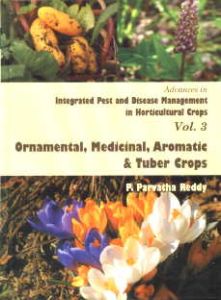
Contents: Vol. I. Fruit Crops: Foreword. Preface. 1. Fruit crops. 2. Tropical fruit crops. 3. Sub-tropical fruit crops. 4. Temperate fruit crops. 5. Arid-zone fruits. 6. Pesticide residues in fruit crops. 7. Some general and useful tips in plant protection. 8. Sources of critical inputs for the management of pests and diseases. References. Subject Index.
Vol. II. Vegetable Crops: Foreword. Preface. 1. Vegetable crops. 2. Solanaceous vegetable crops. 3. Bulbous vegetable crops. 4. Malvaceous vegetable crops. 5. Cruciferous vegetable crops. 6. Leguminous vegetable crops. 7. Leafy vegetable crops. 8. Cucurbitaceous vegetable crops. 9. Root vegetable crops. 10. Mushrooms. 11. Vegetable crops under protected cultivation. 12. Pesticide residues in vegetable crops. 13. Allied topics in pest management. 14. Sources of critical inputs for the management of pest and diseases. References. Subject Index.
Vol. III. Ornamental, Medicinal, Aromatic and Tuber Crops: Foreword. Preface. 1. Ornamental crops. 2. Ornamental crops under protected cultivation. 3. Medicinal plants. 4. Aromatic plants. 5. Tuber crops. 6. Allied topics in pest management. 7. Sources of critical inputs for the management of pest and diseases. References. Subject index.
Vol. IV. Plantation and Spice Crops: Foreword. Preface. 1. Plantation crops. 2. Coffee. 3. Tea. 4. Coconut. 5. Arecanut. 6. Betelvine. 7. Oil palm. 8. Cacao. 9. Rubber. 10. Cashewnut. 11. Tamarind. 12. Spice crops. 13. Black pepper. 14. Cardamom. 15. Ginger. 16. Turmeric. 17. Chilli. 18. Mints. 19. Cinnamon. 20. Other spice crops. 21. Some general and useful tips in plant protection. 22. Sources of critical inputs for the management of pests and diseases. References. Subject index.
"Vol. I: India is the second largest producer of fruits next only to China contributing 10.9% of the total world production. The present area (2005-06) under fruit crops is estimated to be about 5.510 million hectares with an estimated production of 58.740 million tonnes. India is the largest producer of mango, banana and papaya. In grapes, India has recorded the highest productivity per unit area (25.4 tonnes/ha) in the world. Fruits are amongst the most cherished bounties of nature. Of the several factors responsible for lower productivity of fruits, insect pests, diseases and nematode parasites constitute important limiting factors. The first volume deals with pests and diseases of fruit crops and their management using regulatory, physical, cultural, chemical, biological, host resistance and integrated methods.
Vol. II: India is the second largest producer of vegetables next only to China contributing 11.9% of the total world production. In India, vegetables occupy an area of 7.164 million ha with a production of 109.050 million MT during 2006. Vegetable crops contribute 58.93% share to the total production of horticultural crops. Successful cultivation of vegetables is hampered due to the incidence of several insect pests, diseases and nematodes. A total of 65 million MT as pre-harvest losses in vegetables due to diseases alone in the world have been estimated that accounts for 10.5%. The second volume deals with integrated pest, disease and nematode management in vegetable crops in detail using regulatory, physical, cultural, chemical, biological, host plant resistance and integrated methods. This book is a practical guide to growers of vegetable crops.
Vol. III: Floriculture is estimated to cover an area of 126,000 ha with production of 694,000 MT of loose flowers and 2762 million numbers of cut flowers during 2006. Medicinal crops form one of the important groups due to their demand in various pharmaceutical industries and also to earn foreign exchange by way of export. Aromatic crops occupy an area of 0.262 million ha with production of 0.202 million tonnes. The annual tropical root crop production (potato, sweet potato and cassava) is in the range of 11.835m million MT grown in 1.909 million ha with productivity of 19.7 MT/ha. Of the several factors responsible for lower productivity of ornamental, medicinal, aromatic and tuber crops, pests (insect pests, diseases and nematode parasites) are considered as important limiting factors. The third volume deals with the above aspects in detail using regulatory, physical, cultural, chemical, biological, host plant resistance and integrated methods.
Vol. IV: Plantation crops are grown over an area of 3.282 million ha with production of 11.262 million tonnes in India. The plantation crops contributed 6.09% of total horticultural production during 2006-07. The present annual production of spices in the country is 5.107 million tonnes from over 2.857 million hectares during 2005-06. The spices contributed to 2.76% of total horticulture production in 2005-06. The present book deals with integrated pest and diseases management in plantation and spice crops in detail using regulatory, physical, cultural, chemical, biological, host plant resistance and integrated methods. This book is a practical guide to growers of plantation and spice crops."